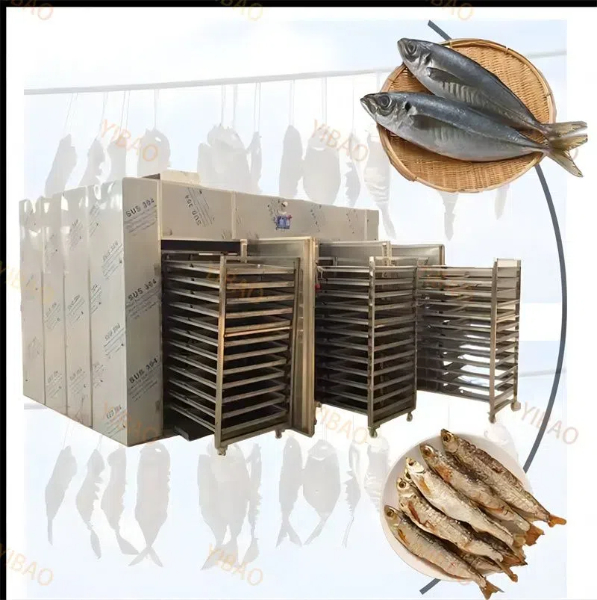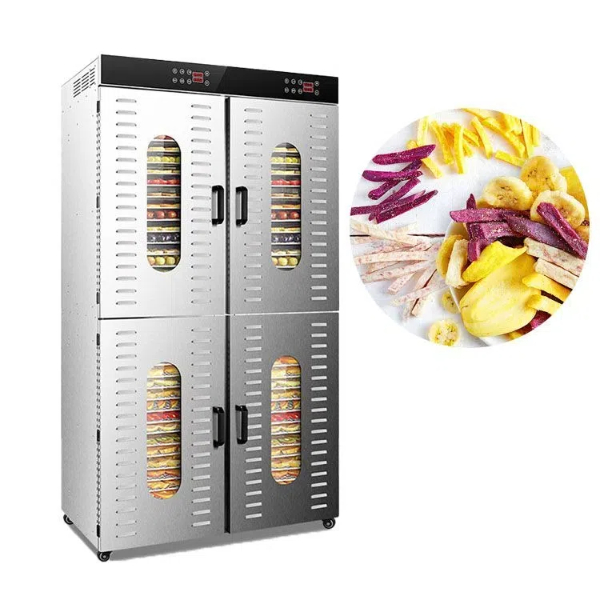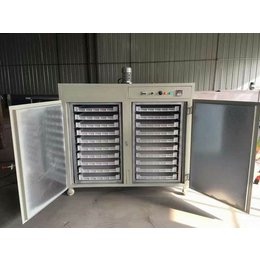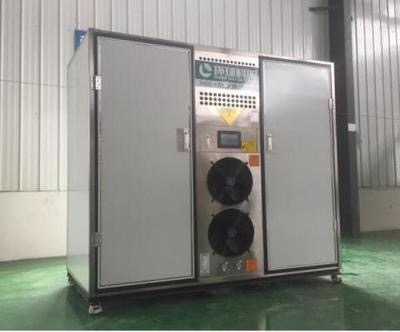
Content Menu
● Introduction
● Understanding Fruit and Vegetable Dryer Machines
● Benefits of Using Fruit and Vegetable Dryer Machines
>> 1. Extended Shelf Life
>> 2. Preservation of Nutrients
>> 3. Space-Saving Storage
>> 4. Cost-Effective
>> 5. Versatility in Culinary Applications
● Types of Fruit and Vegetable Dryer Machines
>> 1. Stackable Tray Dehydrators
>> 2. Box and Shelf Dehydrators
>> 3. Commercial-Grade Dehydrators
>> 4. Solar Dryers
● How to Use a Fruit and Vegetable Dryer Machine
>> 1. Preparation
>> 2. Pretreatment
>> 3. Arranging
>> 4. Setting Temperature and Time
>> 5. Monitoring
>> 6. Storage
● Tips for Successful Fruit and Vegetable Drying
● Popular Fruits and Vegetables for Drying
● Innovative Uses for Dried Fruits and Vegetables
● The Future of Fruit and Vegetable Drying Technology
● Conclusion
● Frequently Asked Questions
>> 1. How long does it take to dry fruits and vegetables in a dehydrator?
>> 2. Are nutrients lost during the drying process?
>> 3. Can I use a fruit and vegetable dryer machine for other foods?
>> 4. How do I know when my fruits and vegetables are sufficiently dried?
>> 5. Is it safe to store dried fruits and vegetables at room temperature?
Introduction
In today's fast-paced world, where food preservation and healthy eating habits are gaining increasing importance, fruit and vegetable dryer machines have emerged as indispensable tools for both home cooks and commercial food processors. These innovative devices offer a simple yet effective way to extend the shelf life of produce while retaining essential nutrients and flavors. In this comprehensive guide, we'll explore the world of fruit and vegetable dryer machines, their benefits, types, and usage, providing you with all the information you need to make the most of these versatile appliances.
Understanding Fruit and Vegetable Dryer Machines
Fruit and vegetable dryer machines, also known as food dehydrators, are devices designed to remove moisture from fresh produce through a process of controlled heating and ventilation. By eliminating water content, these machines help preserve fruits and vegetables, extending their shelf life significantly while concentrating their flavors and nutrients.
Benefits of Using Fruit and Vegetable Dryer Machines
1. Extended Shelf Life
One of the primary advantages of using a fruit and vegetable dryer machine is the significant extension of produce shelf life. By removing moisture, these devices inhibit the growth of bacteria, mold, and yeast, allowing you to store fruits and vegetables for months or even years without refrigeration.
2. Preservation of Nutrients
Unlike some other preservation methods, dehydration helps retain most of the nutrients present in fresh produce. The gentle drying process preserves vitamins, minerals, and antioxidants, ensuring that dried fruits and vegetables remain nutritious and beneficial for your health.
3. Space-Saving Storage
Dried fruits and vegetables occupy significantly less space than their fresh counterparts. This makes them ideal for those with limited storage capacity or for outdoor enthusiasts looking for lightweight, nutrient-dense food options.
4. Cost-Effective
By allowing you to buy produce in bulk during peak season and preserve it for later use, fruit and vegetable dryer machines can help you save money in the long run. Additionally, they reduce food waste by enabling you to dry fruits and vegetables that might otherwise spoil.
5. Versatility in Culinary Applications
Dried fruits and vegetables open up a world of culinary possibilities. They can be used in baking, as snacks, in trail mixes, or rehydrated for use in soups, stews, and other dishes. This versatility makes them a valuable addition to any kitchen.

Types of Fruit and Vegetable Dryer Machines
1. Stackable Tray Dehydrators
These are the most common type of home-use fruit and vegetable dryer machines. They consist of multiple trays stacked on top of each other, with a heating element and fan at the base or top of the unit. Stackable tray dehydrators are versatile, easy to use, and ideal for small to medium-sized batches of produce.
2. Box and Shelf Dehydrators
Box and shelf dehydrators resemble small ovens with removable shelves. They offer more consistent drying results due to their enclosed design and are suitable for larger batches. These machines are often favored by serious home food preservers and small-scale commercial operations.
3. Commercial-Grade Dehydrators
For large-scale operations, commercial-grade fruit and vegetable dryer machines are available. These high-capacity units can handle hundreds of pounds of produce at once and often feature advanced controls for temperature and humidity regulation.
4. Solar Dryers
Solar dryers harness the power of the sun to dry fruits and vegetables naturally. While they require longer drying times and are dependent on weather conditions, solar dryers are eco-friendly and energy-efficient options for areas with abundant sunlight.
How to Use a Fruit and Vegetable Dryer Machine
1. Preparation
Start by washing and thoroughly drying your fruits and vegetables. Remove any blemishes, seeds, or pits, and slice the produce into uniform pieces to ensure even drying.
2. Pretreatment
Some fruits benefit from pretreatment to prevent browning and enhance flavor. This can include dipping sliced fruits in lemon juice or ascorbic acid solution before drying.
3. Arranging
Place the prepared fruits and vegetables on the drying trays in a single layer, ensuring that pieces don't overlap. This allows for proper air circulation and even drying.
4. Setting Temperature and Time
Set the appropriate temperature and drying time based on the type of produce and your machine's instructions. Generally, fruits are dried at slightly higher temperatures than vegetables.
5. Monitoring
Check your produce periodically during the drying process. Rotate trays if necessary to ensure even drying, and remove pieces that dry faster than others.
6. Storage
Once dried, allow the fruits and vegetables to cool completely before storing them in airtight containers. Store in a cool, dry place away from direct sunlight.

Tips for Successful Fruit and Vegetable Drying
1. Choose high-quality, ripe produce for the best results.
2. Cut fruits and vegetables into uniform sizes to ensure even drying.
3. Experiment with different drying times and temperatures to achieve your desired texture.
4. Use herbs and spices to create flavored dried snacks.
5. Rotate trays during the drying process for more even results.
6. Store dried produce in small batches to maintain freshness.
Popular Fruits and Vegetables for Drying
While almost any fruit or vegetable can be dried, some are particularly well-suited to the process:
- Fruits: Apples, bananas, berries, mangoes, pineapples, and apricots
- Vegetables: Tomatoes, carrots, bell peppers, onions, and mushrooms
- Herbs: Basil, oregano, thyme, and parsley
Innovative Uses for Dried Fruits and Vegetables
1. Create your own custom trail mix with dried fruits, nuts, and seeds.
2. Make fruit leather for a healthy, portable snack.
3. Use dried vegetables to create instant soup mixes.
4. Incorporate dried fruits into homemade granola or energy bars.
5. Grind dried vegetables into powders for use as natural food colorings or flavor enhancers.
The Future of Fruit and Vegetable Drying Technology
As technology advances, we can expect to see even more innovative features in fruit and vegetable dryer machines. Some emerging trends include:
1. Smart dehydrators with Wi-Fi connectivity and mobile app control
2. Improved energy efficiency and faster drying times
3. Integration of UV sterilization for enhanced food safety
4. Customizable drying programs for specific types of produce
Conclusion
Fruit and vegetable dryer machines offer a practical and efficient way to preserve nature's bounty, allowing you to enjoy the flavors and nutrients of your favorite produce year-round. Whether you're a home cook looking to reduce food waste or a commercial food processor seeking to expand your product line, investing in a quality fruit and vegetable dryer machine can open up a world of culinary possibilities while helping you save money and eat healthier.
By understanding the benefits, types, and proper usage of these versatile appliances, you can make the most of your fresh produce and explore new dimensions of flavor and nutrition. So why not give fruit and vegetable drying a try? You might just discover a new passion for preserving the best that nature has to offer.

Frequently Asked Questions
1. How long does it take to dry fruits and vegetables in a dehydrator?
Answer: Drying times can vary depending on the type of produce, its water content, and the dehydrator's settings. Generally, fruits can take anywhere from 6 to 36 hours, while vegetables typically dry in 4 to 14 hours. Factors like slice thickness and desired final texture also influence drying time.
2. Are nutrients lost during the drying process?
Answer: While some nutrient loss occurs during drying, particularly water-soluble vitamins like vitamin C, the process preserves most minerals and fiber. Dried fruits and vegetables retain a significant portion of their nutritional value, often in a more concentrated form due to water removal.
3. Can I use a fruit and vegetable dryer machine for other foods?
Answer: Yes, most fruit and vegetable dryer machines are versatile and can be used for a variety of foods. In addition to fruits and vegetables, you can dry herbs, make jerky from lean meats, dry flowers for crafts, or even make yogurt in some models.
4. How do I know when my fruits and vegetables are sufficiently dried?
Answer: Properly dried fruits should be pliable but not sticky, while vegetables should be brittle or crisp. Most fruits will feel leathery when properly dried. You can test by cutting a piece in half – there should be no visible moisture along the cut, and it shouldn't feel cool to the touch.
5. Is it safe to store dried fruits and vegetables at room temperature?
Answer: Yes, when properly dried and stored in airtight containers, fruits and vegetables can be safely kept at room temperature for several months to a year. However, for longest shelf life, store them in a cool, dry, and dark place. Refrigeration or freezing can extend their shelf life even further.












